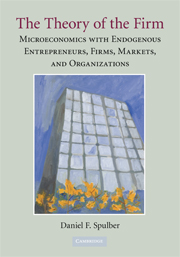 The Theory of the Firm
The Theory of the Firm Published online by Cambridge University Press: 05 June 2012
The separation criterion is fundamental to the theory of the firm. A firm is defined as a transaction institution whose objectives differ from those of its consumer-owners. To understand the firm's economic contribution, it is necessary to derive the firm's objectives endogenously from the choices made by the firm's owners. The neoclassical separation theorem shows that the firm's objective is profit maximization. Although the neoclassical separation theorem provides essential guidance, it is based on several critical assumptions: transaction costs are absent, the firm is defined as a producer of goods, firms take prices as given, and the Walrasian auctioneer chooses market-clearing prices. This chapter extends the separation theorem to accommodate a more general model of the firm. The theory of the firm emphasizes that the firm is more than a producer of goods. The firm chooses prices and creates markets. The discussion in this chapter shows that when firms choose prices, the firm's owners continue to want the firm to maximize profits.
The firm's profit-maximization objective is distinct from the consumption objectives of its owners. Profit maximization by firms is a critical feature of neoclassical analysis of general equilibrium, industrial organization models of imperfect competition, and models of market microstructure. In the theory of the firm, profit maximization drives the firm to select allocations that are more efficient than direct exchange, under some conditions. Profit maximization gives the firm enhanced capabilities in comparison to consumer organizations such as cooperatives, nonprofits, and basic partnerships.
To save this book to your Kindle, first ensure no-reply@cambridge.org is added to your Approved Personal Document E-mail List under your Personal Document Settings on the Manage Your Content and Devices page of your Amazon account. Then enter the ‘name’ part of your Kindle email address below. Find out more about saving to your Kindle.
Note you can select to save to either the @free.kindle.com or @kindle.com variations. ‘@free.kindle.com’ emails are free but can only be saved to your device when it is connected to wi-fi. ‘@kindle.com’ emails can be delivered even when you are not connected to wi-fi, but note that service fees apply.
Find out more about the Kindle Personal Document Service.
To save content items to your account, please confirm that you agree to abide by our usage policies. If this is the first time you use this feature, you will be asked to authorise Cambridge Core to connect with your account. Find out more about saving content to Dropbox.
To save content items to your account, please confirm that you agree to abide by our usage policies. If this is the first time you use this feature, you will be asked to authorise Cambridge Core to connect with your account. Find out more about saving content to Google Drive.